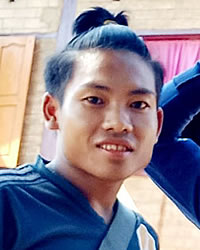Karen, Bwe in Myanmar (Burma)

Photo Source:
Asia Harvest-Operation Myanmar
|
Send Joshua Project a map of this people group.
|
| People Name: | Karen, Bwe |
| Country: | Myanmar (Burma) |
| 10/40 Window: | Yes |
| Population: | 21,000 |
| World Population: | 23,200 |
| Primary Language: | Karen, Bwe |
| Primary Religion: | Christianity |
| Christian Adherents: | 65.00 % |
| Evangelicals: | 60.00 % |
| Scripture: | Portions |
| Ministry Resources: | No |
| Jesus Film: | No |
| Audio Recordings: | Yes |
| People Cluster: | Karen |
| Affinity Bloc: | Tibetan-Himalayan Peoples |
| Progress Level: |
|
Introduction / History
Although they have always been acknowledged as part of the wider Karen race, the Bwe's distinct language and customs mean that they were counted as a separate group during the British colonial period.Bwe Karen people are distributed over a wide area of eastern Myanmar. The main concentration of about 100 Bwe Karen villages is in the Thandaunggyi Township in Kayin State. Others are found further north in Kayah State and in the Bago (formerly Pegu) Region. Because of the decades-long civil unrest in Myanmar, many Bwe Karen families have fled across the border to Thailand.The Bwe language is divided into two dialects, Eastern and Western Bwe. People from each region can usually understand one another despite vocabulary differences, but Western Bwe is more widely used and considered the more prestigious dialect.For centuries, the Bwe Karen were considered “very wild and lawless,” with one book noting: “Every male belonging to this tribe has the rising sun tattooed in bright vermillion on his back, stretching from side to side across the shoulders…. They are diminishing in number owing to the ravages of smallpox.” The Gospel was first proclaimed to the Bwe Karen in 1853 by missionary Francis Mason and his wife, who wrote, “These people are much more lawless than the S'gaw or Pwo Karen, and before we came were ever in a chronic state of warfare.” They saw an immediate response, and by 1857, mission reports listed 42 Bwe churches with 2,640 believers.6 Education also played a key role in transforming Bwe society. By 1857, the missionaries had already established 101 village schools with 2,420 students.7 The schools helped lift many Bwe out of material and spiritual poverty, providing them God-given purpose and dignity as a people.
What Are Their Lives Like?
Prior to the conversion of some Bwe to Christianity, they were feared by other tribes, and in a state of constant hostility with the Geko Karen, the Paku Karen, and the Kayah. In one book, it was noted: “They are wilder and fiercer in their habits than other Karen tribes, and the country in which they live is very mountainous. The construction of their dwellings is peculiar, each village consisting of a single house, built like a bazaar, with rooms on each side of a walk that runs the whole length of the building.”
What Are Their Beliefs?
Early missionaries remarked on the difficulty in reaching the Bwe Karen. Some families, especially those in more remote rural villages, have chosen to keep worshipping the spirits, but most Bwe people today are committed Christians.Despite the up-and-down progress of the gospel among the Bwe Karen, today around two-thirds of Bwe people are Christians, with most of them attending Baptist churches. Portions of the Bible were translated into Bwe Karen in 1857, but by then the entire Bible had been translated into S'gaw Karen, and Bwe Christians have used it ever since, even though it is not in their heart language.
What Are Their Needs?
Bwe Karens need revival fire to draw them into a passionate relationship with the King of kings.
Prayer Points
Pray for the Holy Spirit to send a transforming revival to the Karen Christians in Thailand and Myanmar.Pray for them to become Christ's ambassadors to animists and Buddhists in their areas.Pray for the Lord to give some the gift of healing so they can demonstrate the power and goodness of the Lord of lords.Pray for the Lord to bless the work of their hands through an abundant crop on their farms.